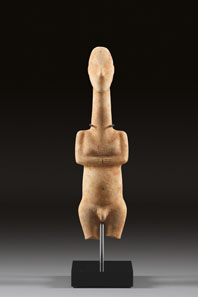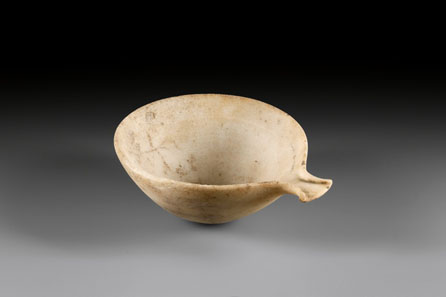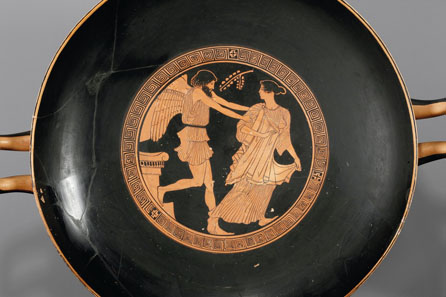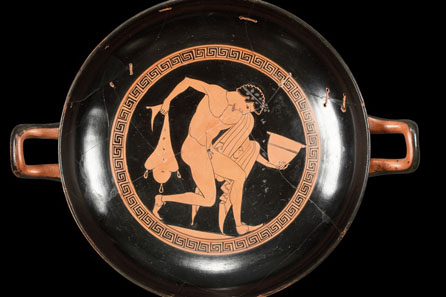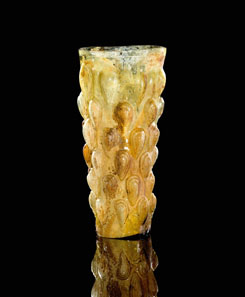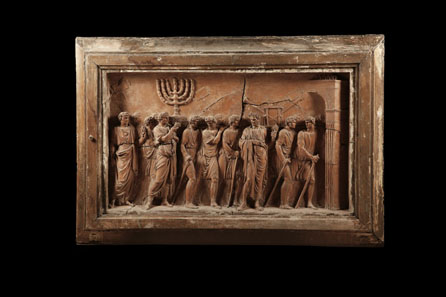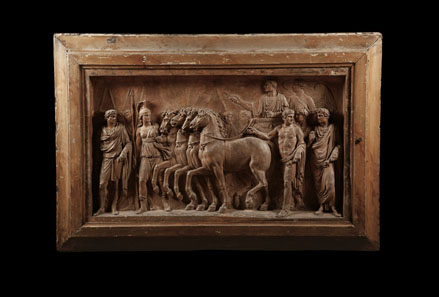13-12-2011 – 01-01-1970
Auction 202 – Antiquities
Maximum prices for objects from the Waltz Collection
Every collection reflects the personality of its collector. Michael Waltz (1938-2010) had achieved something extraordinary. He had the knack of combining art objects of great beauty and expressiveness in such a way that the ensemble became a testimony of nice taste, profound technical expertise and great love for Greek art. The objects of his collection, that were auctioned off on December 14, 2011, with Gorny & Mosch, yielded maximum prices without exception. Not a single piece was returned. The total estimate of 380,000 Euros for the 70 lots was exceeded many, many times by the end result of 2.2 million Euros!* The rest of the auction likewise went admirably. Evidently, many a collector becomes an investor these days who justifies the purchase of a desired object with the conservation of value. Consequently, Gorny & Mosch can be pleased with the total end result of 3.4 million Euros.
2: Male Cycladic idol. Marble. H 21cm. Early Cycladic I, Plastiras type, c. 3200-2700 B. C. From Waltz Collection, 1970s. Estimate. 25,000 Euros. End result: 322,000 Euros.
Already the start of the auction hinted at what was to be coming. The head of a Cycladic idol, made between c. 2700 and 2500 B. C., was estimated at 15,000 Euros. The end result read more than ten times this sum, i.e. 149,500 Euros! An even bigger price was obtained by a male Cycladic idol, created a little bit earlier than the previous one, c. 3200 and 2700 B. C. The magnificent sculpture with its height of approximately 21 cm realized 322,000 Euros, hence more than twelve times its estimate of 25,000 Euros.
21: Cycladic bowl with sprout. Early Cycladic II, c. 2700-2400 / 2300 B. C. H 6.5 cm, diameter 13.5 cm. Marble. From Waltz Collection, 1970s. Estimate: 8,000 Euros. End result: 126,500 Euros.
Rather unspectacular at first sight seemed a Cycladic bowl with sprout, made about 2700-2400 / 2300 B. C. The modest estimate of this thin-walled stone vessel was 8,000 Euros. A collector was willing to pay a bit more for this very rare piece, 126,500 Euros, to be precise! Comparatively inexpensive was an at least equally rare fragment of an early Classical grave relief from Eastern Ionia with the delicate depiction of a woman’s head. The high-quality work of art was estimated at 10,000 Euros. The end result was 103,500 Euros.
Likewise high prices were obtained by the ceramic objects from the Waltz Collection. An Attic neck amphora with simple geometric decoration, made as early as 800-750 B. C., was sold for 27,600 Euros (estimate: 4,000 Euros).
56: Attic bowl of the Penthesilea Painter, c. 460 B. C. H 15.9 cm, diameter without handles 34.8 cm. From Waltz Collection, 1970s. Estimate: 30,000 Euros. End result: 126,500 Euros.
Even more expensive became an Attic neck amphora with lid. The black-figure decoration most probably was done by a great master. Archaeologists list similar pieces in a group that was named Würzburg 199, after a famous example kept in the very city. The front of the vase shows a young hoplite preparing for battle in the company of his father and a woman (his wife or his mother?). On this piece, one can marvel in detail at the entire armor of a Greek warrior. This showpiece had carried the moderate pre-sale price tag of 30,000 Euros. The end result read 126,500 Euros. Same estimate, same result: the Attic bowl of the Penthesilea Painter, created around 460 B. C., beguiles with its dainty depiction of its interior. The chilly North Wind Boreas grabs the Nymph Oreithyia, daughter of the Attic king Erechteus. The bowl’s exterior is decorated with boon fellows enjoying themselves in the procession of Dionysos, called Komos.
53: Attic bowl of Onesimos. About 490 B. C. H 9.3 cm, diameter without handles 23.2 cm. From Waltz Collection, 1970s. Estimate: 20,000 Euros. End result: 414,000 Euros.
All these results were put in the shade by an Attic bowl of the master Onesimos, produced around 490 B. C. On the interior a komast is depicted, holding a wineskin in one, a drinking vessel in the other hand. The exterior is decorated with a gorgeous depiction of a buoyant symposion with a hetaera playing double flute. Just 20,000 Euros was the estimate in the catalog. A connoisseur paid 414,000 Euros for this magnificent vessel.
Even though the Waltz Collection without doubt was an event of distinction, the other results were likewise remarkable. A small Geometric bronze horse with a height of 12.5 cm was estimated at 25,000 Euros. The end result read 48,300 Euros.
98: Lotus bud bowl. H 19.5 cm. Diameter 8.7 cm. 2nd half of 1st cent. A. D. Syria? English Collection. Estimate: 40,000 Euros. End result: 66,700 Euros.
A lotus bud bowl, most probably made in the second half of the 1st cent. A. D., perhaps in Syria, had been acquired by an English collector in the 1980s. 40,000 Euros – that was the pre-sale price tag the auctioneers had attached to this exquisite piece; 66,700 Euros – that was the sum a collector was willing to pay for it.
Even if that may look like as if ancient art was something for people of means only, auction 202 of Gorny & Mosch nonetheless contained numerous pieces that might well give the admirer great pleasure for comparatively little money. Let’s recall the wonderful clay lamps Gorny & Mosch offered an entire ensemble of. The bigger part of it came from a Rhenish private collection. For only 200 Euros it was possible to purchase an item here, although such gorgeous examples like a Roman clay lamp with a port scene naturally cost many times more than that.
382: Figured lamp in the shape of a spitz. L 9 cm. 1st cent. A. D. Estimate: 300 Euros. End result: 276 Euros.
This object, estimated at 350 Euros, changes hands for 4,600 Euros. Let’s take a look at another price extreme – in order to make clear that ancient art is affordable for everyone. 276 Euros was the price the winner of an oil lamp in the shape of a small dog paid – gladly, in all probability. The superb piece had been made in the 1st cent. A. D. and was completely intact.
576: Terracotta bozzetto of the reliefs of the Arch of Titus. One of two terracotta reliefs, 60 x 100 cm (without frame). 1st half of 19th cent. For both estimate: 75,000 Euros. End result: 109,250 Euros.
This report shall be concluded by a historically quite interesting lot, with two terracotta bozzetti of the reliefs of the Arch of Titus. Most probably they had been created at the beginning of the 19th century when the Arch had been stripped of its additions. Usually, similar bozzetti served as models for art works in the making.
576: Terracotta bozzetto of the reliefs of the Arch of Titus. One of two terracotta reliefs, 60 x 100 cm (without frame). 1st half of 19th cent. For both estimate: 75,000 Euros. End result: 109,250 Euros.
It is likely that the bozzetti offered here had been intended as models for creating additions to the famous reliefs with the depictions of the triumph of Titus over the Jews – fortunately, though, this didn’t happen. This special lot was estimated at 75,000 Euros, but sold in the end for 109,250 Euros.
Further results can be viewed here.
Don’t fail to order the catalog of the upcoming auction of Antiquities, to be conducted in June 2012. Please contact Gorny & Mosch, Giessener Münzhandlung, Maximiliansplatz 20, D-80333 Munich, phone: +49-89-2422643-0, or via email.
* All prices include 15 % buyer’s fee.




